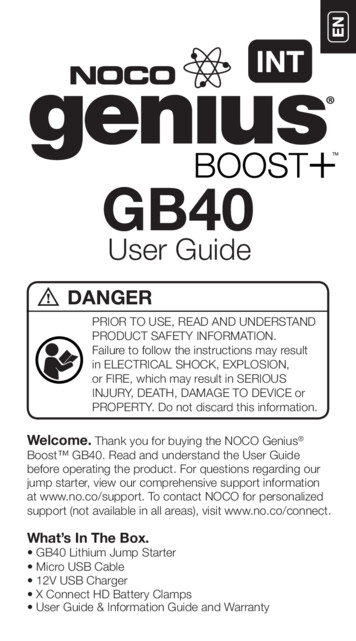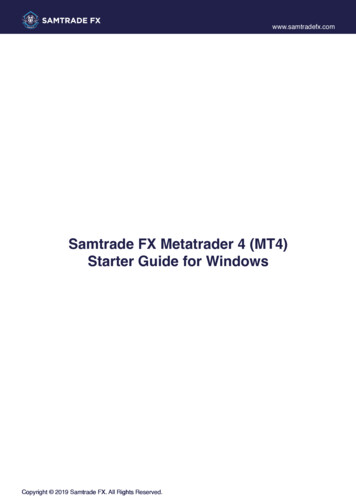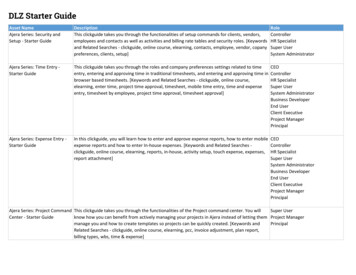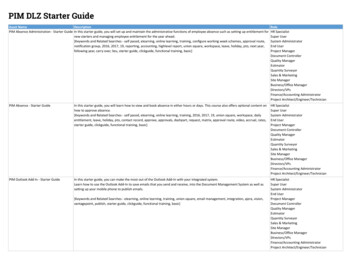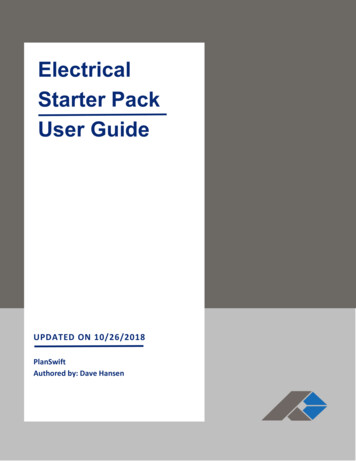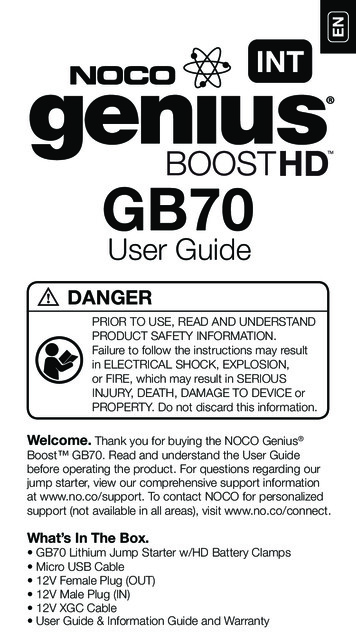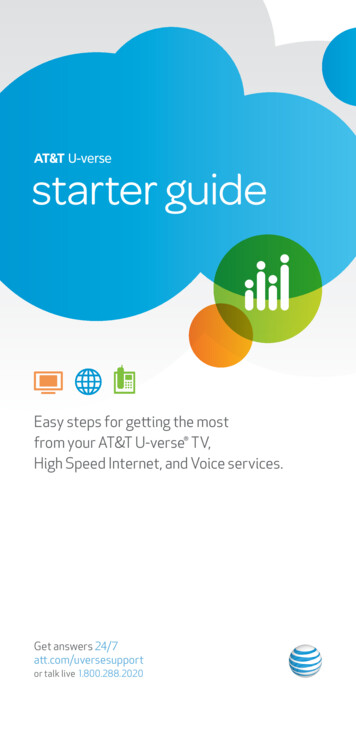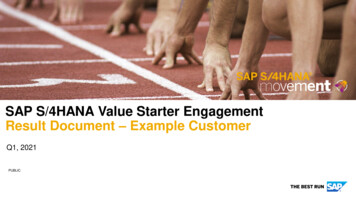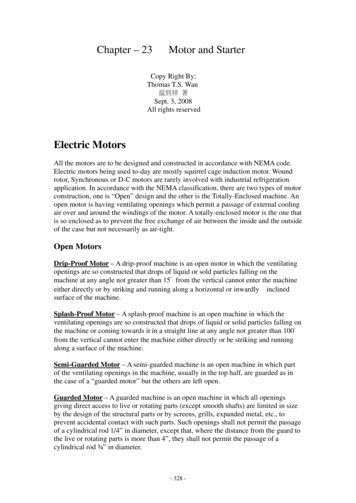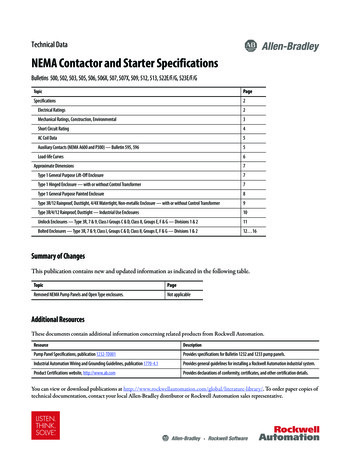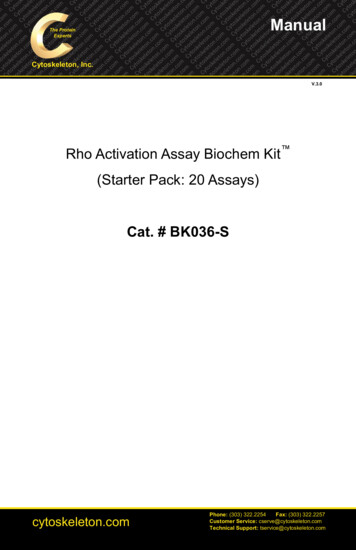
Transcription
The Project ManagementStarter Guide forNon-Project Managers
Chapter 1What’s ProjectManagement?And are you secretly a project manager?5
Just because your business card doesn’t say Project Manager doesn’t mean youaren’t one.Take this quick survey. At your job, do you ever: organize a team of people around a set of tasks? find yourself responsible for getting a certain job done, whether it be byyourself or with a team? create timelines and budgets? create plans for a project, oversee the completion of the project, and then findyourself looking back on the project and exploring what went right and whatwent wrong?If you answered yes to any of the above, you’re a project manager—even if it’s notpart of your job title.6
What Does the SecretProject Manager Look Like?The Secret Project Manager probably didn’t go to business school. She probablydidn’t get a management degree. The Secret Project Manager might be anengineer, a computer science graduate, a marketer, an advertiser or an editorialmanager.She or he is any person that leads a team of people towards a certain goal—andreally, that could be anyone. They find themselves accountable to stakeholders,gives status updates on projects to higher-ups, or oversees budgets and resourcesfor a team of people.Congratulations, You’re a Project Manager!(And You’re Going to Be Just Fine)Congrats on your newfound title of Project Manager! Have we scared you? Does itsound all fancy and nebulous? The good news it’s that it’s not. The good news isthat we’ve created this guide just for YOU, the project manager who doesn’t knowshe’s a project manager yet—and you’re going to be just fine.Whether you’re the Marketing Project Manager, Engineering Project Manager, ITProject Manager, or PM of any other kind, we’ve got your back. We’ll cover all thebasics you need to succeed in your role, including: what a project is, the skillsyou need to make things run smoothly, and the 5 phases of a project—includinggetting things kicked off right and wrapping everything up at the end.And by the end of it? You’ll be a pro.7
What Is a Project?Ah, our first lesson. We did say we were going to keep things simple andstraightforward, didn’t we? Did we? Well, we are. This guide is for those of youwho haven’t even ever used the words “project management” at work, so we’regoing to start from the bottom and work our way up.Here’s our definition of a project.A project is a set of tasks grouped together with a common goal in mindthat: 1) has a clear start and finish; 2) creates something new (even if it already exists elsewhere); 3) has boundaries (such as project scope and specifications); 4) and has someone in charge or someone personally invested inthe outcome.Whew! What a mouthful. Let’s break it down.8
A Project Has a Beginning and EndWhat do we mean by that? Basically, a project has a scope, or a clear start, finish,and summary of everything that needs to get done in between.It’s not going to go on forever or even for a long period of time spanning, say, afew years (unless you’re in research or architecture—then it might!). If it did goon for years at a time, it’d more likely be called a program, which is a group ofprojects with a common goal that are usually recurring and similar in scope, butjust spread out over time.But we won’t get into that now. All you need to know is that a project needs a startdate and an end date and an overview of what needs to happen in between. Clearboundaries like these—even if there isn’t really a deadline by which the tasksneed to be done—give us a nice, neat structure to work within that makes it easyto set time-bound goals and get stuff done.A Project Creates Something NewYou’re doing it now because you haven’t done it already.That’s not to say, if you’re an advertiser, you’ve never created a mockup for an adbefore. But maybe you’ve never created a mockup from this photo shoot, with thiskind of copy, and for this month’s magazine of, say, Women’s Health. You’ve builtmockups, but not like this.It’s not the first advertising mockup to ever be created, but it is new informationthat you want your audience to see. Because you wouldn’t spend more time andresources building the same ad twice, would you? Of course not.9
A Project Has BoundariesJust like that beginning and end we talked about earlier. But let’s emphasize thescope again here. The scope isn’t just about start and end dates. It’s also about: all the deadlines for the tasks in between (“milestones”) what resources will be involved (what money and from where, whose laborhours) what the tangible deliverables of the outcome are.If you don’t get these down first, your project could end up out of control and offthe rails, sucking up time and resources like a destructive and unruly Godzilla.A Project Has Someone In ChargeWho asked you to do this project? Your immediate supervisor? Your cofounder? Ordid you decide yourself that this project needs to get done?Whatever the case, there needs to be someone in charge, someone the projectleaders can hold themselves and their team accountable to. Someone somewhereis personally invested in this project, and we’re going to make them proud. (Evenif the person is ourselves!) Even if “Project Manager” isn’t in your job title,you could still be one A project is a set of tasks grouped together by a common goal A project has boundaries, creates something new, and hassomeone in charge10
Chapter 2The Skills YouNeed to Succeed11
Do you have what it takes?Usually project management isn’t about just doing one thing right, but succeedingin lots of little areas to motivate others, keep tasks moving and managing all theunknowns for the project to reach fruition.1. Master the ScheduleYep, time management. Even if there are no real, hard deadlines,make some. Create your team’s schedule and stick to it.2. DelegateAnother word for it? Prioritize. Because even though you sometimes want to doevery task yourself to make sure it’s done right, we just don’t have time for that.3. Get OrganizedYou know the drill. A tidy desk is a tidy mind. A clear-cut projectplan aids in success.Use a project management tool to keep all the information that’llgo along with your project organized. (More on PM tools later.)4. Manage RiskAs a project manager, you’ve got to be able to strike that fine balance betweenbeing risk averse but also being willing to take the right risks where it counts.How will you know what the right risk is? You won’t—that’s the nature of risk.But the mental soundness to dissect the pros and cons of risk without getting allfrazzled about it will take you far as a PM.12
5. Lead & FacilitateManaging meetings, checking in on team members, handlingideas and complaints, and facilitating discussion. All of it. Oh—andit doesn’t hurt to care about them as people, too. Compassion,communication, conviction—it’s all part of being a good leader.6. Negotiate & Beat the BudgetGoing over budget is not an option.Well, it is an option, but the good project manager does whatever she can to avoidit. Kicking off with a budget plan will help this in the beginning; negotiating andgetting creative with resources will help during the rest. (More on budget talk later.)7. Be Quick, Be FlexibleA calm swiftness when making confident decisions is the mark of good management.Be quick and sound in your decision-making; be flexible when things go wrong.Because they will. So be the rock your team can lean on.8. Think CriticallyYou’re emotionally invested in this, sure. But sometimes you’re going tohave to think over things like you’re not. Objective thinking will get youfar when you need to take a step back and see the forest for the trees.9. Be Tech SavvyTechnology is having us communicate, lead, manage, and track more eicientlythan ever before. Use it. Get comfortable with it and make sure your team does,too. The right tech tools in your toolbox can help your team move mountains.13
10. Communicate Well (& Often)Which isn’t just about talking to your team. It’s also listening, coaching, negotiating,resolving conflicts, and giving feedback.11. Stay Calm, Stay SaneKeep in touch with your sense of humor—your sanity will thank you for it. Staylevelheaded, stay objective, and don’t take failure personally. Your mind will be ina much clearer state to lead that way. It takes a mixture of many traits to succeed as a PM Manage time, risk, tasks, and your budget Be organized, quick, and flexible Communicate Get comfy with technology Stay objective, calm, and sane14
Chapter 3The Phases of a Project15
The plan, from start to finish.Now we’re getting into the meaty stuff.The next few sections will go over each of the 5 phases of a project in depth, soget cozy as we dive in.16
1. StartMany PMs call this Initiation. Here’s where we figure out the big why of our project.What’s the purpose? To gather a certain number of leads? To sell a certain numberof products? To completely revamp your social media presence?Identify the high-level reasons for your project and the hurdles you might facealong the way. Address these goals, fears, and frustrations. We’re going to lay itall out on the table in Phase 1.2. Create a Project PlanNext, we’re going to take all that stuff we addressed in Phase 1 and put it in writing(or a project management system).It’ll need to answer questions like: What’s our budget? What tasks do we need to do to accomplish our goals? What do we do when we get off track? What’s the process for making changes and corrections?We need a detailed plan like this so your team feels supported by a strongfoundation, an easy-to-reference road map. We’ll cover goals, scope, tasks,scheduling, dependencies, milestones, and deliverables.3. Execute the PlanWhere the rubber meets the road. Your team must be invested in the project,so it’s time to rally. In this phase, we’ll assign tasks and milestones, addressdependencies, and get clear on deliverables. We’ll get started on the right foot bycommunicating clearly.A good PM strikes a fine balance between hands-off and hands-on, sitting back tolet their team do their thing while stepping in when needed.17
4. Watch the PlanAh, the best laid plans. Things will go wrong, that’s no question. The question is:how will we handle it when they do go wrong?In Phase 4 we’ll talk about dealing with challenges and changing course. We’ll talkabout adjusting milestones, the budget, and resources to do whatever we can tokeep the project on track.5. Close the ProjectAnd raise a glass.But first, let’s talk about let’s make sure our stakeholdersare happy with the results. Let’s talk about performancereviews, for team members and project leaders. Let’stalk about what went wrong and what went right sowe can take these lessons with us to the next project. Phase 1 kicks off the project with purpose and direction Phase 2 is all about planning the project Phases 3 and 4 will be about project execution and maintenance Phase 5 closes out the project with approval from stakeholdersand a look back on how things went18
Chapter 4Starting Your Project19
Phase 1 of 5You wouldn’t embark on a journey without a reason or map. But if you start aproject without a plan or purpose, that’s essentially what you’re doing.But we can’t sit down and write a plan until we know what we want. Until we getthe big why clear in our minds. Let’s talk about discovering that why and gettingtabs of what resources we have to accomplish it.20
State Your CaseYour business case, that is. You’re going to use up company resources for thisproject, so why do you want to do it in the first place? Why is it worth it? What’syour case? First we’ll figure that out; from there we’ll be able to materialize someobjectives.PurposeYour purpose, your case, your big why—it’s all essentially the same thing here.You’ll probably have a what followed by a greater why. It could look like this: Design and submit an ad (what) to run in Women’s Health Magazine; toincrease brand awareness (why) among a certain type of potential customer Create an app (what) that will share company information; to position yourcompany and department as helpful and service-oriented Completely redesign your company’s website (what); to show yourcustomers you’re tech savvy (why), to make sure they have a pleasantexperience on your website (another why), to foster positive brandassociation in your readers’ minds (another why!)Or it could be something totally different. As long as you’ve got the big what andwhy(s), you’re good to go so far.21
Gather MaterialsWhile we’re on this first step, go ahead and gather any materials you can get yourhands on that might have anything to do with the project so far.If it’s a project resulting from a recent sale by an account manager in your company,get as much information as you can from that deal closer. They’ve done a bit offootwork so far in the selling process, so let’s use what they’ve got already.You’ll want to ask for: the Statement of Work (SOW) - the document your deal closer likely usedin the closing process to nail down specifics about goals and deliverables a draft schedule - it’s likely they’ve talked deadlines already, so use this asa starting point to bang out your project schedule a draft budget - to quote the customer, your deal closer likely had to comeup with some kind of draft budget. We’ll talk about using this more below. any other information you can get on the client/biggest stakeholder - whatare their likes and dislikes? Does your deal closer have any notes on theirquirks, pet peeves, style, or expectations? Do they have any wireframes,mockups or sketches you can have?If there’s not a deal closer in the picture, find the most knowledgeable personinstead, which could be the customer (if you’re working with them directly) or yoursupervisor. The biggest stakeholder—that’s your guy.Gather allllll this stuff. We’ll be using it below and referencing it throug
Take this quick survey. At your job, do you ever: organize a team of people around a set of tasks? find yourself responsible for getting a certain job done, whether it be by yourself or with a team? create timelines and budgets? create plans for a project, oversee the completion of the project, and then find yourself looking back on the project and exploring what went right .
